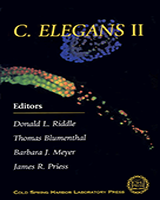NCBI Bookshelf. A service of the National Library of Medicine, National Institutes of Health.
Riddle DL, Blumenthal T, Meyer BJ, et al., editors. C. elegans II. 2nd edition. Cold Spring Harbor (NY): Cold Spring Harbor Laboratory Press; 1997.

C. elegans II. 2nd edition.
Show detailsAs mentioned above, the approximately 100 SL1 RNA genes are clustered with the 5S rRNA genes on a 1-kb repeat (Krause and Hirsh 1987). The 5S and SL1 RNA genes are arranged with their 5′ends apposed, with less than 200 bp between them. Although it is not clear whether this arrangement has any functional significance, it suggests that the 5S and SL RNA genes could share a regulatory region. However, the 5S rRNA gene is transcribed by RNA polymerase III, whereas the SL1 RNA gene is transcribed by RNA polymerase II (Maroney et al. 1990b). The presence of SL RNA and 5S genes in a short tandemly repeated unit is found in other nematodes (e.g., the parasites Brugia malayi and Onchocerca volvulus [Tackacks et al. 1988; Zeng et al. 1990]), and even in some trypanosomes (Herpetomonas samuelpessoai and Trypanosoma vivax) and Euglena gracilis (Aksoy 1992; Keller et al. 1992; Roditi 1992); however, in other nematodes and in the trypanosomes, both genes are on the same strand. Furthermore, there are nematode species in which the SL RNA genes are not clustered with the 5S genes (e.g., the free-living species Panagrellus redivivus and the parasite Haemonchus contortus [Bektesh et al. 1988]).
Transcription of the SL1 RNA gene requires the SL1 sequence itself, which serves as a binding site for a transcriptional activator (Hannon et al. 1990b). In addition, the SL1 RNA gene has a good match to the consensus C. elegans proximal sequence element (PSE), found upstream of all the C. elegans snRNA genes (Thomas et al. 1990). By analogy with the vertebrate PSEs, which have a different sequence, this sequence is presumed to be the site at which the SNAPc complex binds to activate transcription of both the SL RNA and the other snRNA genes (Henry et al. 1995).
SL2 RNA is encoded by a small gene family scattered throughout the C. elegans genome (Huang and Hirsh 1989), as are the other snRNA genes. Recently, a variety of SL2-related sequences have been identified (Kuwabara et al. 1992; Ross et al. 1995). These variant SL2s are trans-spliced onto the same set of mRNAs that receive SL2. They are also encoded by genes with sequences quite closely related to SL2 RNA. The existence of these variants suggests that the SL2 sequence may not serve as a binding site for a transcription factor, as the SL1 sequence does, since it has not been as highly conserved.
- Organization and Transcription of Spliced Leader RNA Genes - C. elegans IIOrganization and Transcription of Spliced Leader RNA Genes - C. elegans II
Your browsing activity is empty.
Activity recording is turned off.
See more...